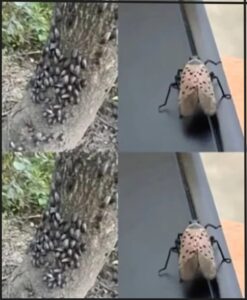See This Bug? Act Fast Before It Destroys Your Garden and More

An Invasive Menace Spreading Across the U.S.
An uninvited guest is wreaking havoc on farms, forests, and even backyard trees—the spotted lanternfly (Lycorma delicatula). Originally detected in Pennsylvania in 2014, this invasive pest has rapidly infested multiple states, threatening agriculture and natural ecosystems in its path.
How Spotted Lanternflies Wreak Havoc
These bugs may look striking, but their impact is far from pretty.
Using sharp, straw-like mouths, lanternflies puncture plants to suck out sap, weakening them over time. This constant feeding stresses the plants, making them more vulnerable to illness, poor growth, and environmental damage.
Even worse, they leave behind a sticky residue known as honeydew. This gunk invites black sooty mold to grow, which coats leaves and blocks sunlight—interrupting photosynthesis and choking the plant’s ability to thrive.
How to Recognize a Spotted Lanternfly
They’re hard to miss—if you know what to look for:
-
Adults: Grayish wings speckled with black dots. When they fly, vivid red and black underwings appear.
-
Size: About one inch in length and width.
-
Resting appearance: With wings folded, they blend in easily.
-
Nymphs: Start out black with white spots. As they mature, they turn red and black before adulthood.
Their Favorite Food? A Long List
These pests aren’t picky. Their feeding menu includes:
-
Maple and other hardwood trees
-
Fruit trees, especially grapevines and pear trees
-
Agricultural crops, including hops
Lanternfly invasions have already devastated grape harvests in some vineyards—and that’s just the beginning.
Not Just a Nuisance
The lanternfly isn’t just a garden pest. The scale of its impact is much larger:
-
It can sicken and even k*ll ornamental trees in neighborhoods
-
It disrupts biodiversity, harming birds, beneficial insects, and the local ecosystem
Urban areas, rural farms, forests—they’re all at risk.
What to Do Right Now If You Spot One
Don’t ignore it. Here’s what you need to do immediately:
-
K*ll It On Sight
Whether it’s an adult or a nymph, stomp it or swat it. Every one destroyed helps slow the spread. -
Destroy Egg Clusters
Look for grayish, mud-like smears on trees, fences, vehicles, or furniture. Scrape the mass into a container filled with rubbing alcohol, hand sanitizer, or bleach. -
Report It
Contact your state’s agriculture department or invasive species hotline. Your report could help prevent an outbreak in a new area. -
Check Before You Travel
When moving outdoor items like lawn furniture, firewood, or vehicles, inspect them thoroughly. Lanternfly eggs hitchhike and may hatch in new areas if left unchecked.
The Fight Starts With You
Lanternflies spread by clinging to everyday items. That means community effort is the only real defense. When everyone is aware and vigilant, these invaders stand less chance.
You don’t need to be an expert to help. Spot it. Stop it. Report it.
Final Thought: Don’t Hesitate
This pest multiplies fast and spreads even faster. The sooner you act, the better chance we have to protect crops, forests, and neighborhoods.
If you see one, don’t let it live another minute. Your action matters.